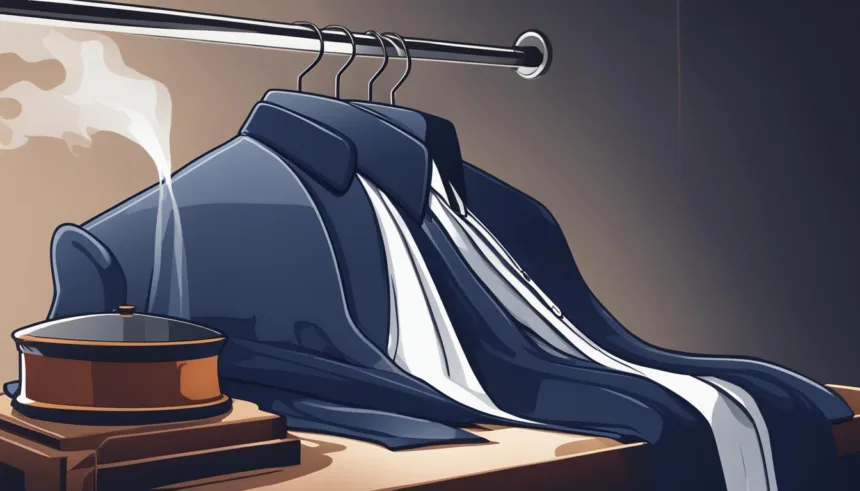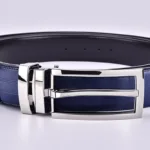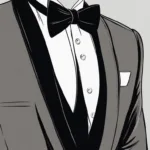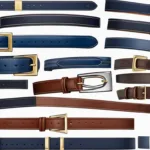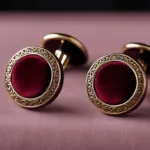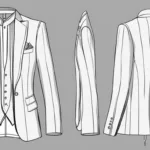When it comes to maintaining a professional edge, the sharpness of a navy business suit is paramount. Mastering the navy business suit ironing techniques is thus essential for anyone looking to stand out in the corporate arena. As you stand before your ironing board, it’s pivotal to understand that this task is more than just removing wrinkles—it’s about preserving the refined appearance and the integrity of the fabric. Ironing tips for navy suits often forewarn about the risks of shine and damage, especially concerning wool fabrics.
Given these concerns, pressing a suit with care involves specific techniques tailored for each part, ensuring your navy suit continues to signify sophistication and attention to detail. Whether you’re refreshing your attire for an upcoming meeting or prepping for a business trip, achieving a sharp look with navy suit ironing requires skill and an appreciation for the craft. Arm yourself with these ironing guidelines to guarantee that your appearance remains as impactful as your business acumen.
Understanding Navy Business Suit Fabrics and Ironing Needs

When it comes to ensuring your navy business suit looks its best, knowing how to care for its fabric is key. The type of fabric dictates the ironing temperature and technique necessary to achieve a wrinkle-free appearance without causing damage. Unraveling the specifics of each fabric type and their corresponding care requirements will go a long way in maintaining your suit’s sharpness and longevity.
Identifying Different Fabrics of Navy Suits
Each fabric type that makes up navy suits has its unique characteristics and demands specific ironing approaches. Popular fabrics for navy suits include wool—favored for its elegance—cotton, linen, and various synthetics. Each one interacts differently with heat and steam, making a keen understanding of your suit’s material an essential part of the ironing process.
Selecting the Right Iron Settings for Navy Business Suits
An iron’s temperature setting can be the difference between a crisp suit and a damaged one. For wool, you require a lower heat setting to avoid scorching the fabric. Cotton and linen, on the other hand, can endure higher temperatures for effective crease removal. Always begin by checking the suit’s label for ironing directions tailored to its fabric blend, and adjust your settings accordingly for safe ironing practices.
The Importance of Fabric Care Before Ironing
Before you pick up your iron, ensure that both the pants and the iron itself are clean to prevent any transfer of dirt or residue. Furthermore, using distilled water in your iron can help ward off limescale deposits that would be particularly noticeable on a dark fabric like navy. Proper preparation is a vital step toward implementing techniques for wrinkle-free navy suits, ensuring they keep their pristine look and feel.
| Fabric Type | Iron Heat Setting | Care Tips |
|---|---|---|
| Wool | Low | Use distilled water; press with cloth |
| Cotton | Higher than Wool | Can use steam; crisp finish achievable |
| Linen | Highest | May require additional moisture |
| Synthetics | Varies | Check label; use gentle heat |
The Preliminary Steps to Ideal Ironing
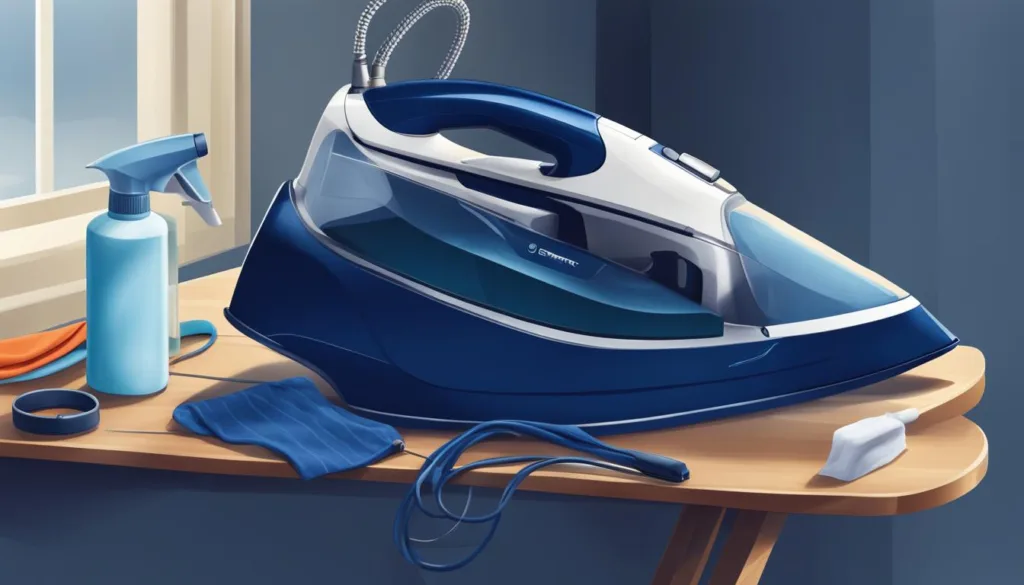
As you embark on the journey to master the step-by-step guide to ironing navy suits, your first move involves compiling the essential tools. A successful ironing session starts with preparation, and proper navy suit care through ironing is no different. Acquiring the correct equipment will lay the foundation for a sleek, professional finish, free of unsightly wrinkles or damage.
Having the right tools at your disposal is critical for maintaining your navy business suit’s impeccable appearance. Let’s walk through a checklist of what you will need to guarantee a seamless ironing experience.
Gathering Essential Ironing Tools
- An ironing board apt for the task: It should be sturdy and large enough to hold different components of your suit.
- A tailored tailor’s ham: crucial for pressing the curved areas of your suit without leaving marks.
- Quality pressing cloth: to protect your navy suit from becoming shiny, especially if it’s wool.
A thorough ironing process requires not just skill but also the best instruments you can equip yourself with. The strength of the iron, the structure of the board, and the effectiveness of your pressing cloth are all cornerstones to achieving an exemplary ironed suit.
Prepping Your Iron for the Task
Ironing is an art that demands both precision and the appropriate hardware. Your iron is the star of this endeavor, ensuring each crease is as sharp as your business acumen. Here’s how to prepare it:
- Select an iron with substantial weight, offering high-pressure steam and numerous steam holes to tackle stubborn wrinkles.
- Adjust the iron’s temperature to align with the delicate nature of your navy suit, typically requiring a lower setting for wool.
- Use distilled water in your iron to prevent the buildup of limescale that could mar the fabric.
- For optimum results, consider an ironing board with a vacuum feature to improve efficiency and finish.
Equip yourself with these authoritative ironing tools as they will serve not only to alleviate creases but also to maintain and even enhance your suit’s longevity. Remember, the precision in preparation is just as vital as the execution when aiming for superior navy suit care through proper ironing.
Navy Business Suit Ironing Techniques

Ironing a navy business suit requires a strategic approach, as many pitfalls can damage the fabric or affect the suit’s sharp appearance. Central to avoiding ironing damage on navy suits is the understanding that different parts of the suit need varying ironing methods. This attention to detail is what ultimately leads to achieving a sharp look with navy suit ironing. Below you’ll find tailored advice to press your trousers impeccably while maintaining the suit’s timeless style.
To begin, focus on the trousers, as they typically present the greatest challenge. A crisp central crease is the trademark of well-ironed trousers, often aligning with the pre-existing lines. Professionals suggest a methodical technique: press the iron down firmly and then lift—don’t drag. Such care is necessary to avoid ironing damage like unwanted shine on the fabric, particularly pertinent to wool materials.
One must also approach steam with restraint. Excessive steam can cause the underlayer of trouser legs to pucker and wrinkle, defeating the purpose of ironing. Crucially, it’s the balance of temperature, weight, and motion that will deliver that crisp, sharp look essential to a navy business suit.
The following table outlines the key techniques and considerations to adopt when ironing each component of your navy business suit:
| Suit Component | Ironing Technique | Tips to Avoid Damage |
|---|---|---|
| Trousers – Crease | Press and lift, align crease | Bypass dragging movement |
| Trousers – Legs | Minimal steam, press one leg at a time | Avoid excess moisture that puckers fabric layers |
| Jacket – Lapels | Gentle pressing, shape retention | Use a pressing cloth to prevent shine |
| Jacket – Body | Even distribution of pressure | Take care with seams and buttons to prevent imprints |
By adhering to these techniques, you can maintain both the structural and aesthetic quality of your suit. Ironing is not just about smoothing out the fabric but also about upholding the integrity of your suit’s construction. Therefore, handle your garments with the attentiveness they deserve—respect the fabric, observe the seams, and employ a touch of finesse—and you will be rewarded with an impeccably sharp and professional look.
Achieving a Sharp Look with Navy Suit Ironing
For the discerning professional, ironing a navy business suit to perfection is a fine art. The meticulous creation of crisp creases and a sleek appearance is essential, ensuring that you display a silhouette of sartorial precision. Getting the technique right for a wrinkle-free navy suit is about understanding the nuances of fabric care and applying the right amount of heat and steam.
Creating Sharp Creases for a Professional Finish
To begin, the essential objective with your navy suit pants is the crispness of the crease. Proper alignment at the top and bottom seams is your starting point, confirming the correctness before applying any heat. With a deft hand, press along these lines, then harness the power of a wooden tailor’s clapper—this classic tool, when applied after ironing, imparts an extra sharp edge to your creases. Bear in mind, the beauty of a smoothly ironed wool trouser lies in its subtlety; hence, for ironing tips for navy suits, less is more when it comes to steam.
Techniques for a Sleek and Wrinkle-free Appearance
Wool, the traditional choice for navy suits, handles differently under an iron than other fabrics. Patience and precision are vital in avoiding a glossy finish, an unwelcome byproduct of ironing. Relegate the use of steam to the sidelines, favoring instead a light mist to relax any stubborn wrinkles. Techniques for wrinkle-free navy suits call for motion that’s more pressing than sliding—entice the wrinkles out rather than coercing. Keeping these methods in mind will ensure your navy suit maintains that much-coveted crisp, authoritative flair that your professional wardrobe requires.



